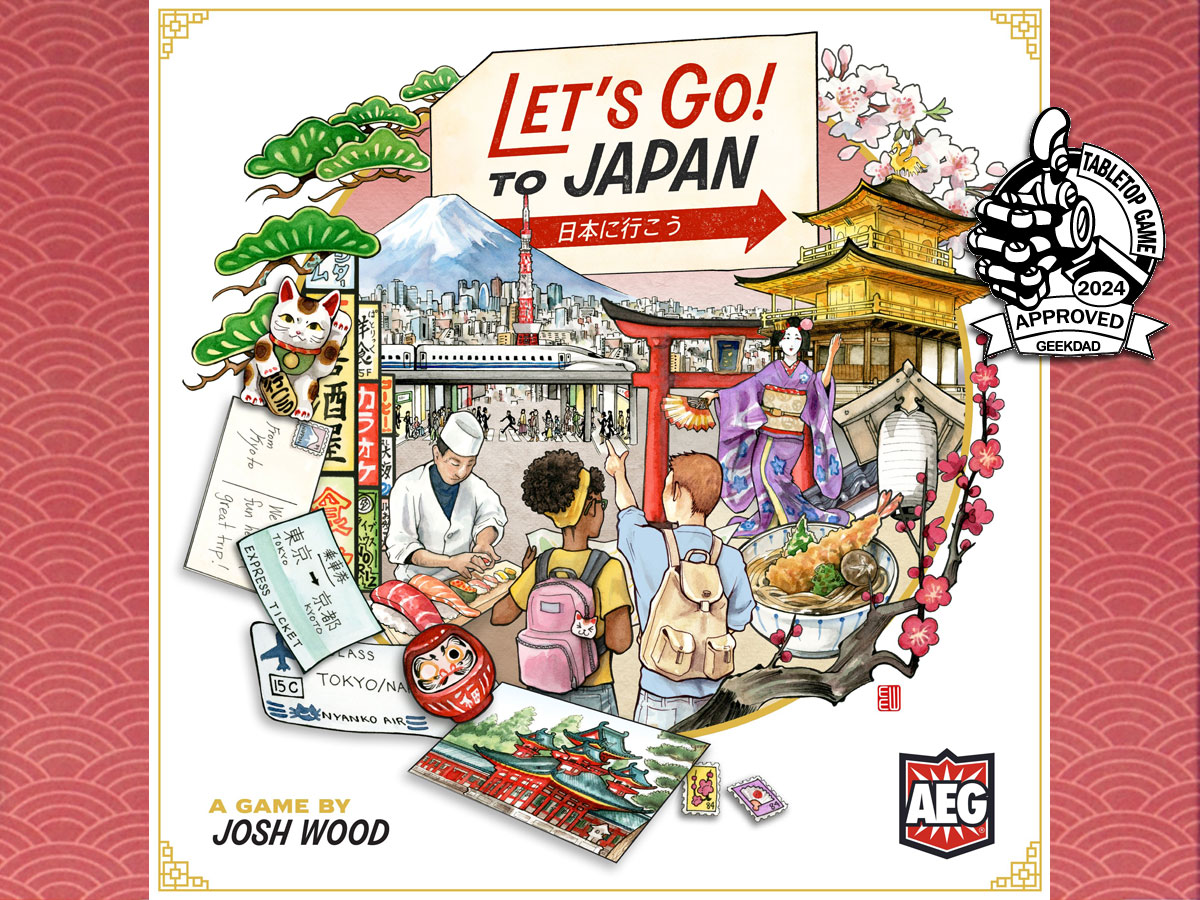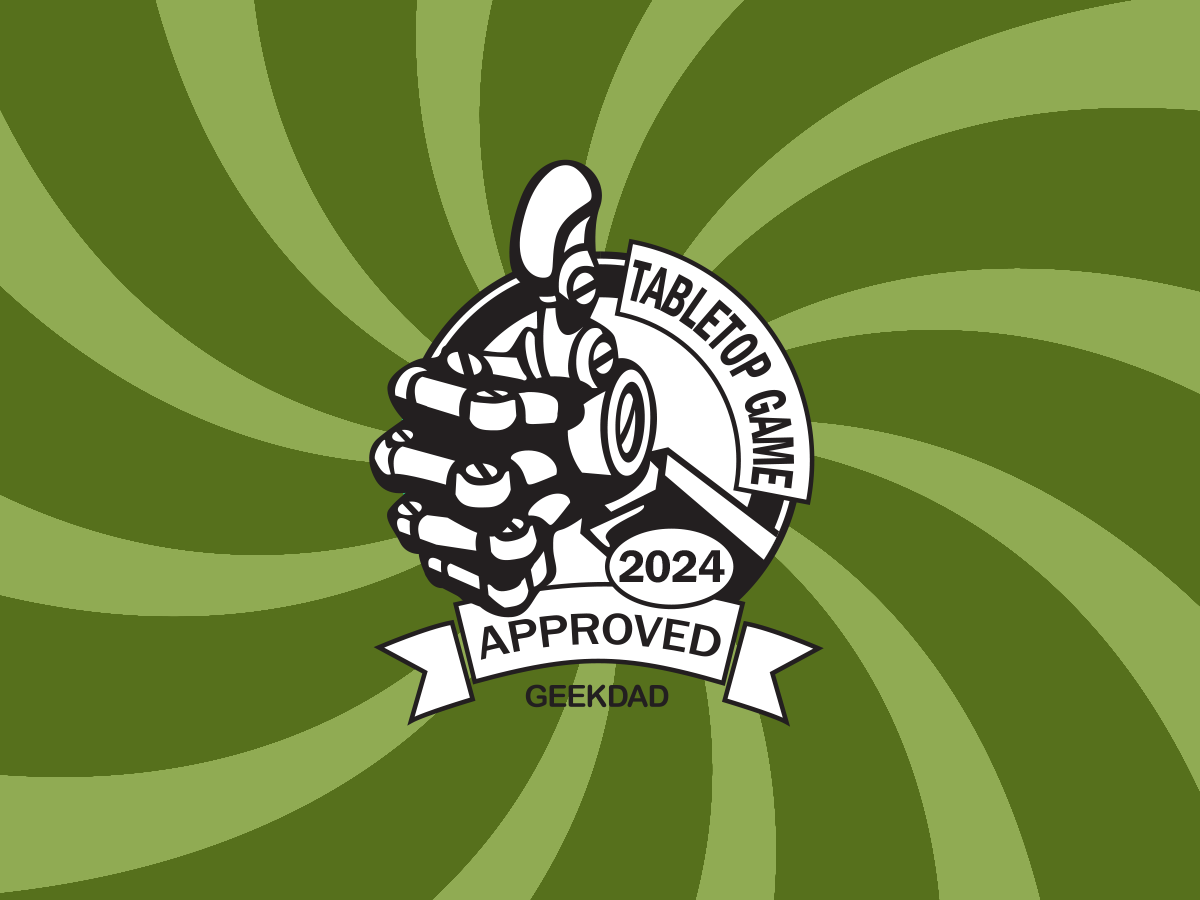Plan out a trip to Tokyo and Kyoto, trying to experience all that the cities have to offer!
What Is Let’s Go! To Japan?
Let’s Go! To Japan is a card game for 1 to 4 players, ages 10 and up, and takes about 45 minutes to play. It retails for $49.99 and is available in stores and directly from AEG. The theme is about trip planning and is family-friendly, though it may depend on how much your kid is interested in Japan and/or the joy of putting together a schedule!
Let’s Go! To Japan was designed by Josh Wood and published by AEG, with illustrations by Chaykov, Kailene Falls, Toshiyuki Hara, Magdalena Pruckner, Erica Ward, and On Yamamoto.
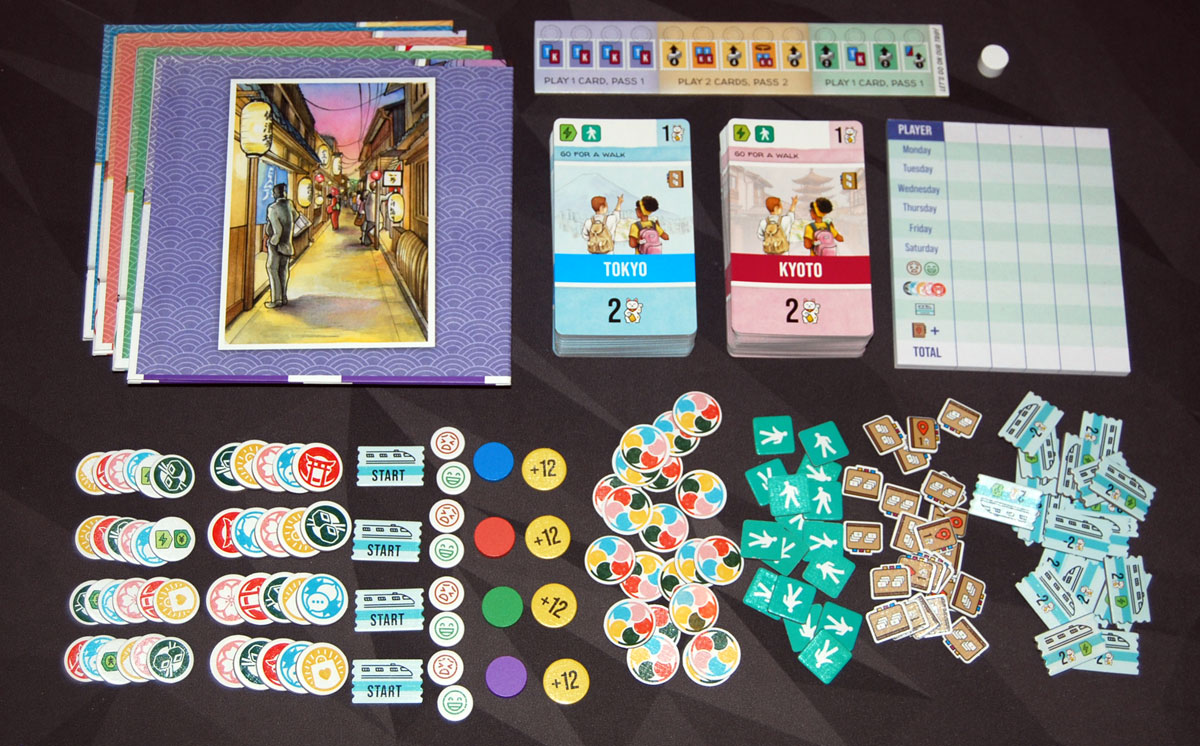
Let’s Go! To Japan Components
Here’s what’s included:
- 160 Activity cards (80 Tokyo, 80 Kyoto)
- Round tracker board
- Round tracker token
- 21 Train tokens
- 20 Wild tokens
- 24 Research tokens
- 16 Walk tokens
- Scorepad
- 4 sets of player components, each including:
- Player board
- 6 Favorable Condition tokens
- 5 Experience tokens
- 1 Starting Train token
- 1 Happiness token
- 1 Stress token
- 1 Mood token
- 1 +12 token
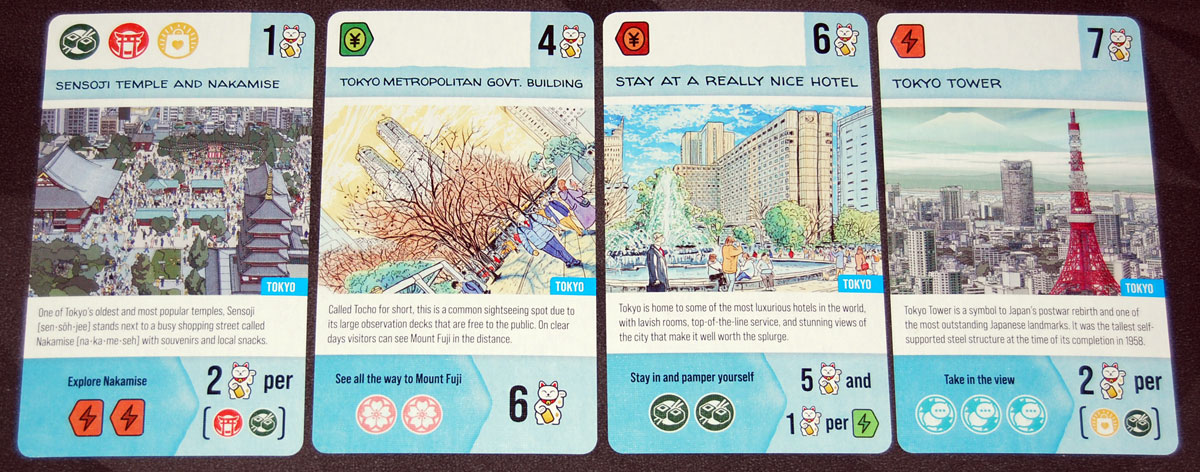
The cards are all extra-large, making for plenty of room for the illustrations and a bit of text that wouldn’t be out of place in a travel guide. The game-specific parts of the card are at the top and bottom; when the cards are overlapped, only the top part of the covered card is relevant so it’s a nice way to remember that. The large cards do mean that each player needs a good amount of space on the table, though.
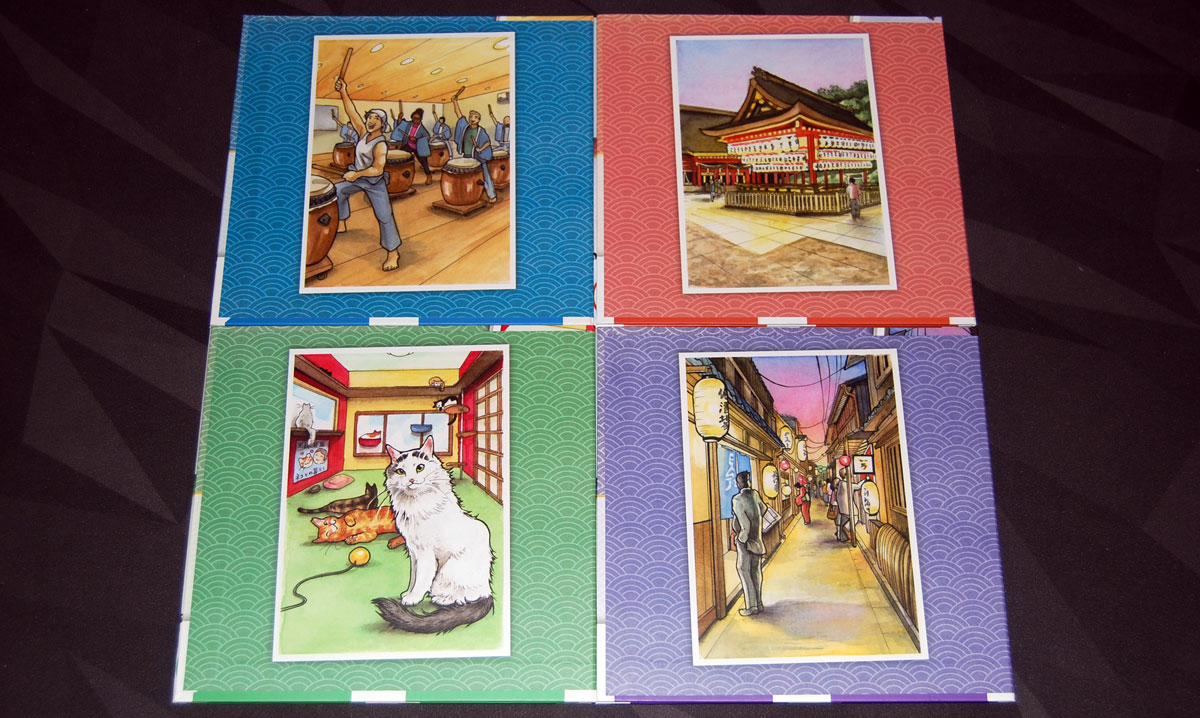
The player boards are tri-fold boards, mostly with a few different tracks, since your cards will be played below the boards. One nice decorative touch is that the backs of the boards have different colors and illustrations (taken from some of the activities). Player color doesn’t really matter in this game since everyone’s just playing on their own boards anyway, but it adds a little bit of extra personality to the game.

There are a lot of different tokens—they’re mostly all easily distinguished from each other, though the favorable condition tokens and experience tokens feature the same icons and are only slightly different in size.
How to Play Let’s Go! To Japan
You can download a copy of the rulebook here.
The Goal
The goal of the game is to score the most points by planning activities on the most favorable days and meeting the requirements to experience highlights during your trip to Japan.
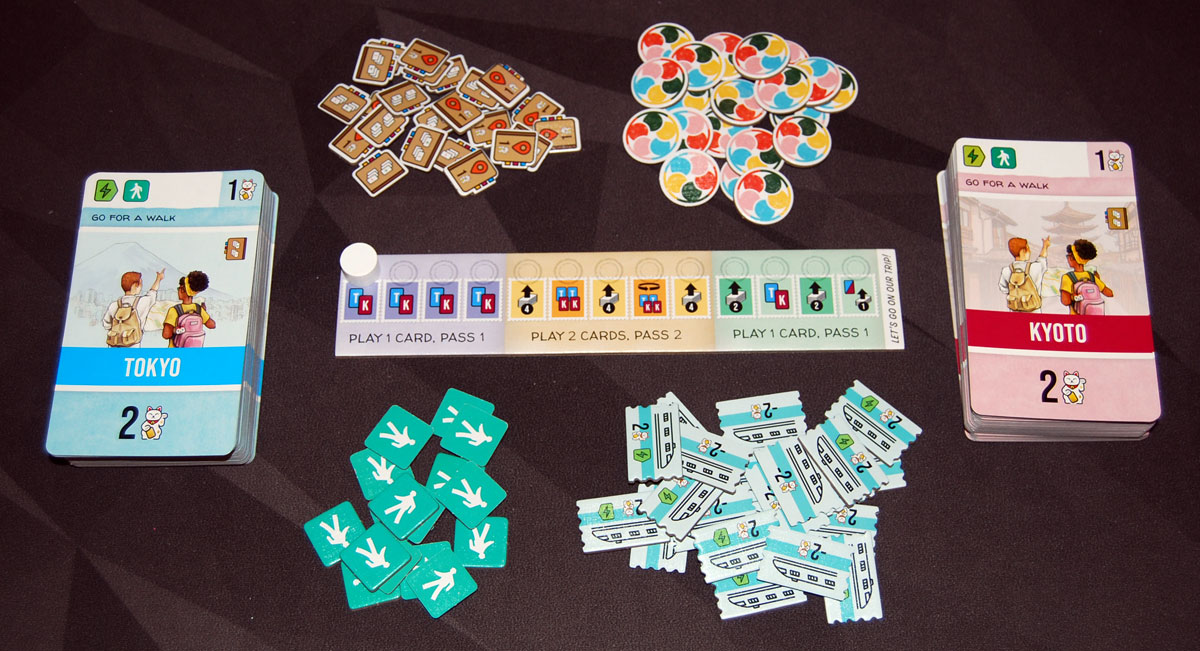
Setup
Shuffle the two decks of activity cards separately and place them within reach of all players. Place the round tracker board in the center and place the marker on the first round. Make a supply of the other tokens: train tokens, wild tokens, research tokens, and walk tokens.
Give each player a set of player components: a player board and all of the various tokens. The mood token (wooden disk) goes on the center of the mood track, with the stress and happiness tokens placed at the beginning of each corresponding track. The five experience tokens are placed at the 0 space of your board.
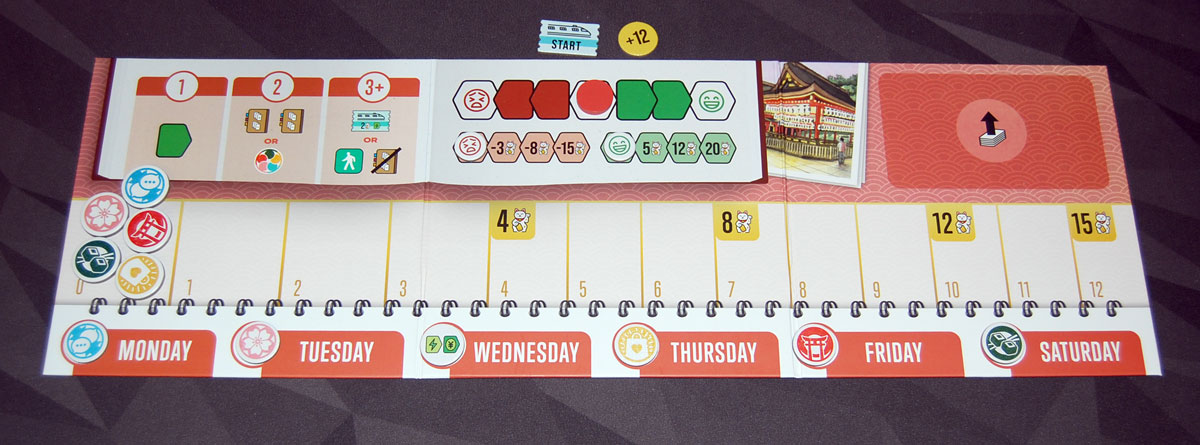
One player should mix up the six favorable condition tokens and place one on each day at the bottom of their board, and then everyone else should arrange theirs to match. Be sure to leave room to play cards below your player board. Set your starting train token and +12 token nearby.
Gameplay
Let’s Go! To Japan takes place over 13 rounds, with players creating a trip itinerary by placing activity cards below their player boards from Monday to Saturday. The cards may be placed anywhere in your itinerary (up to 3 cards per day), but once placed cannot be moved later. At the end of the 13 rounds, players then take their trips as planned, accumulating experiences and scoring points.

At the top of your board is a mood tracker—your mood goes up when you do things that are relaxing or inexpensive, and your mood goes down when you’re exhausted by crowds or strenuous activity, or when you’ve overspent a bit. Whenever your mood hits either end (with the sad face or happy face), move the appropriate tracker one space and then set your mood back to the middle. Your stress and happiness have penalties and bonus points at the end of the game.

Planning Trips
Each round, players will simultaneously draw cards and then play and pass cards as indicated by the round tracker board. For instance, in the first four rounds, players draw one card from each deck (Tokyo and Kyoto), and they will play one card into their schedule and pass the other card clockwise, placing it face-down at the top of that player’s board. Some rounds indicate that you pick up the passed cards instead of drawing from the decks, and in the middle five rounds you play two and pass two. Starting in round 8, you will pass counterclockwise instead.
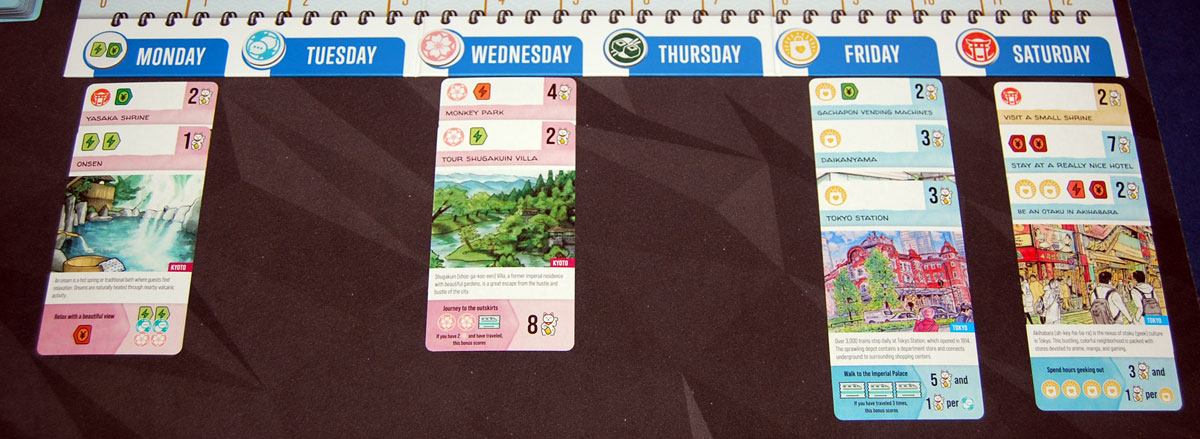
As you place your cards, you generally want to group cards of the same city, because every time you switch between the two cities, you have to spend a train ticket. Also, you’ll get bonuses for matching that day’s favorable conditions, so there is an incentive to play matching cards on those particular days. Cards are placed overlapping so that the top section of each card is visible; only the last card of the day is fully visible, showing the highlight at the bottom.
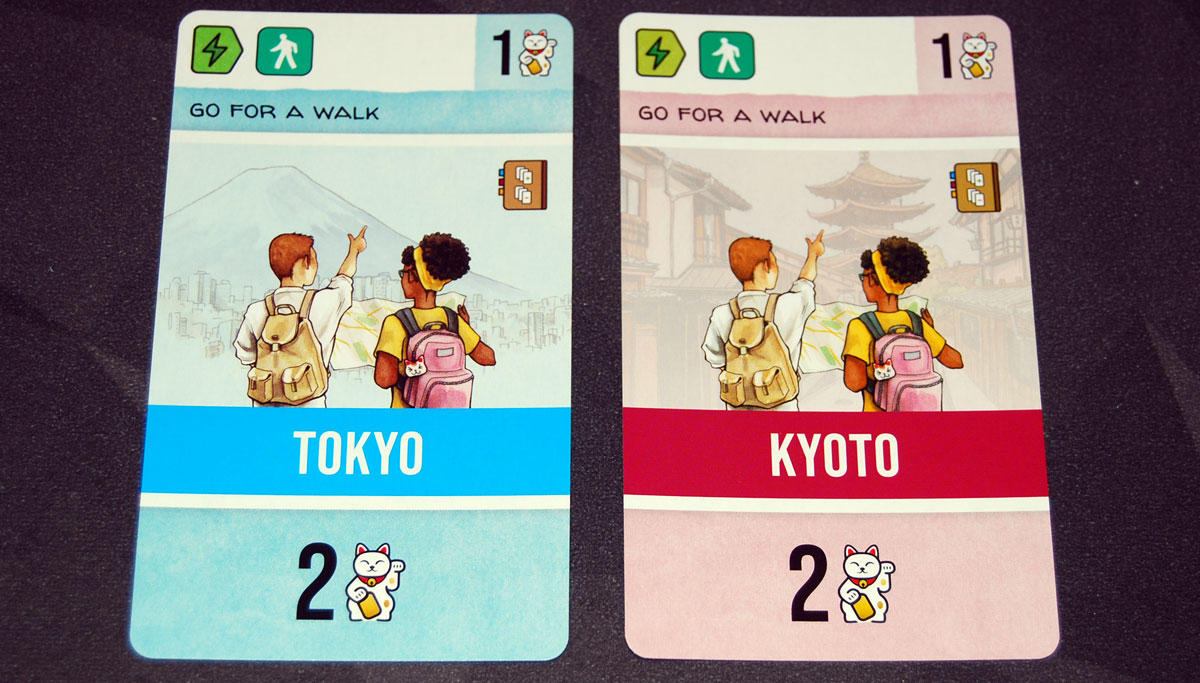
If you don’t like any of your options, you may also “go for a walk.” Discard one of the cards from your hand, and then draw a card from either deck and place it face-down in your itinerary without looking at it. You immediately gain a research token. When that time slot arrives on the trip, you’ll reveal the card and decide whether it’s an activity you want to do.
Research tokens may be spent at any time to draw 3 cards, and then discard 3 cards.
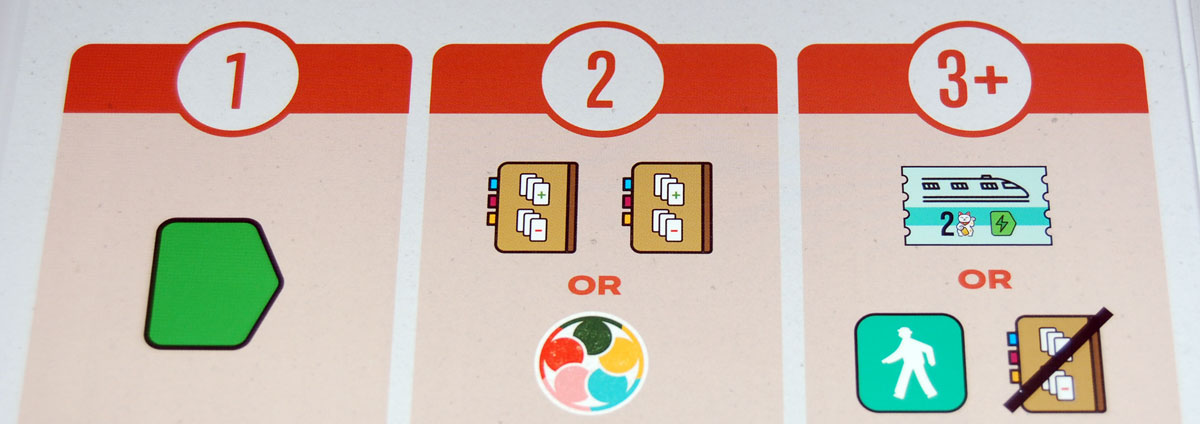
Whenever you add the third card in the same day, you check to see how many of that day’s favorable condition icons appear on those cards, which can earn you an immediate bonus. You may only choose one of these bonuses (but you may take a lower tier than what you’ve earned):
- At least 1 icon: Move your mood tracker 1 space to the right
- At least 2 icons: Take 2 research tokens or 1 wild token
- At least 3 icons: Take 1 luxury train token or go on an extra walk
The “extra walk” option lets you draw a card from either deck and place it face-down as a 4th card for that day. This bonus walk does not let you take a research token.
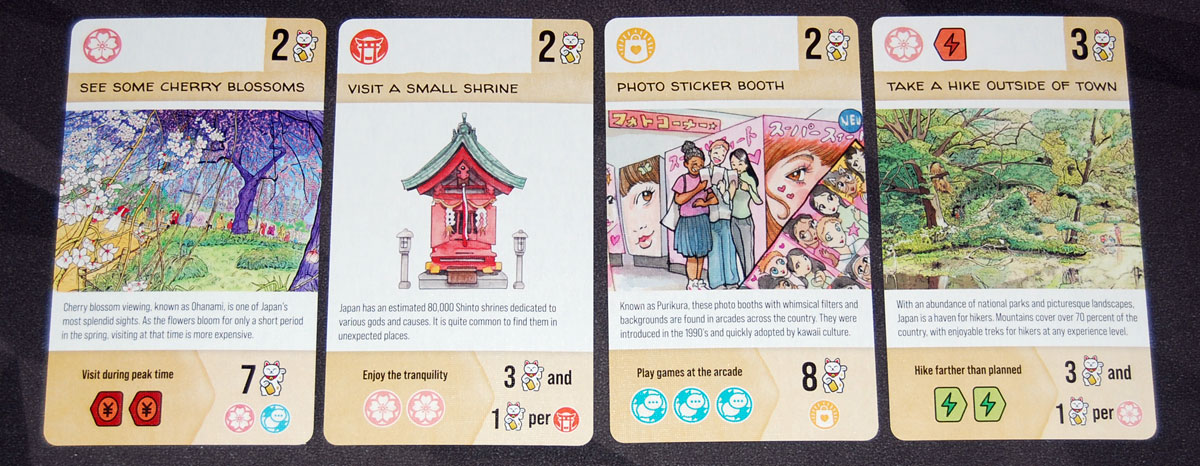
Going on Trips
After the final round of planning, everyone will have a full itinerary, with 3 cards on each day (plus potentially bonus walk cards). Now, it’s time for everyone to take their trips and see how well they scored!

First, check for every time that your itinerary switches between the two cities, and place a train token there (even if the switch happens between days). You have one free train token from setup. Luxury train tokens, gained as a bonus, will give you 2 points and increase your mood when you use them. For all of the required trips that you don’t have enough train tickets for, you must take a regular token from the supply, placing it on the “lose 2 points” side.
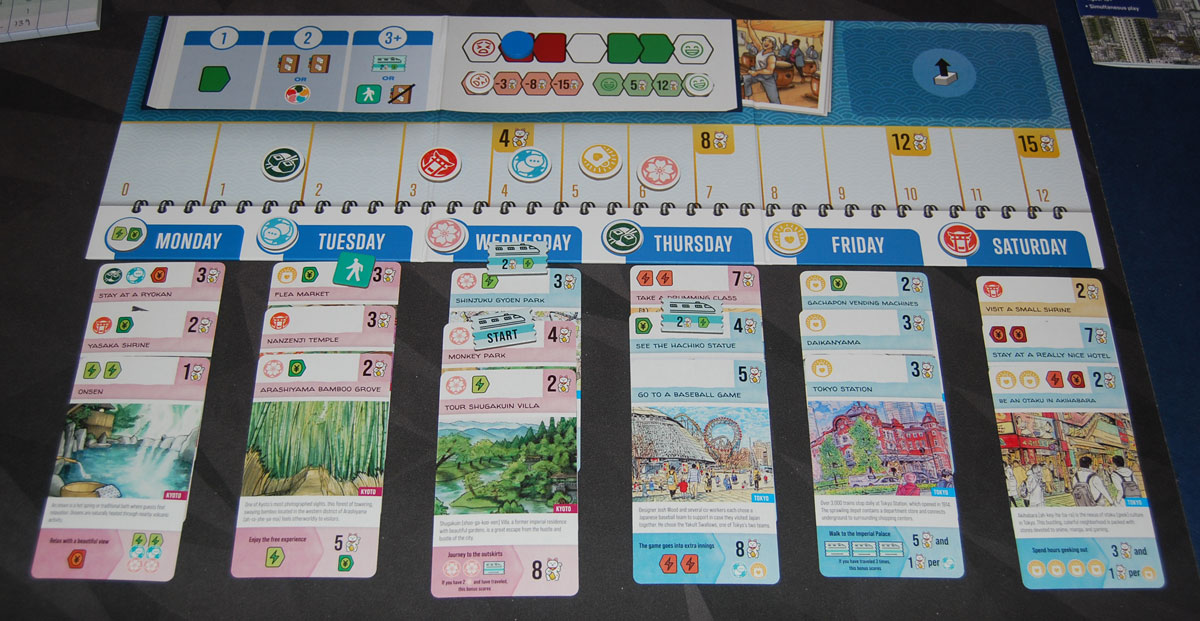
Each player goes through their itinerary one day at a time, scoring the cards from top to bottom. For each card, if there are experience or mood icons on the top of the card, move the appropriate tokens to keep track. The cat symbol on the top right corner is points for that card.
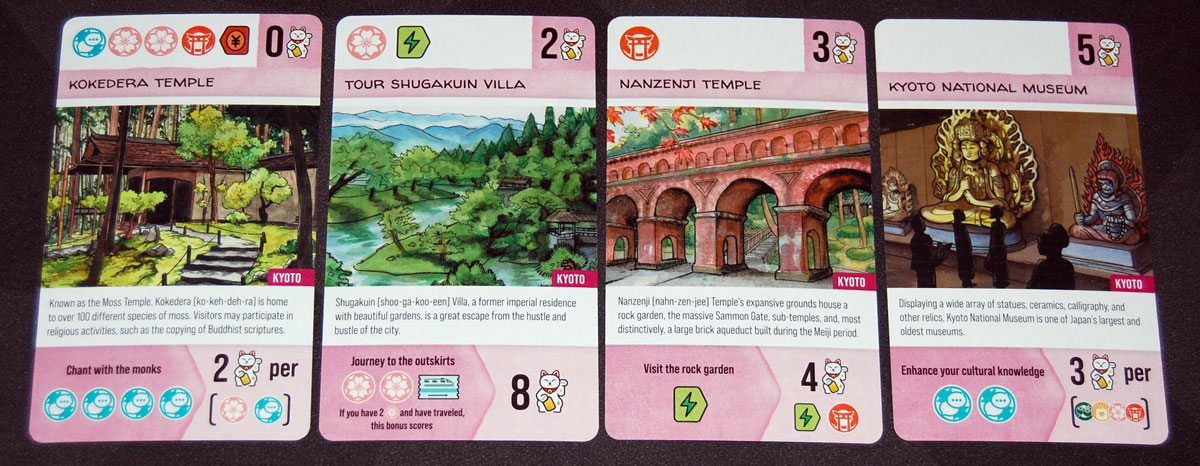
The last card of each day has a highlight of the day bonus at the bottom. Generally, you will score bonus points or earn bonus experience if you have met the requirements already. If you earned wild tokens as bonuses during the planning phase, you may spend them at any time to get any 1 experience per token spent, which can help you fulfill those requirements.
If you have a “walk” card, you may reveal it, and decide which side to use. You may keep it on the walk side, which is worth 1 point and 1 increased mood, as well as 2 points for the highlight if it’s the last card of the day. Or, you may use the activity you discovered on your walk, in which case it scores as if you’d played it that way (but it also still counts as a “walk” in case that is a requirement for later).
Game End
Your score is as follows:
- Scores for each individual day’s activities
- Penalties and bonuses for stress and happiness
- Points for each of your experience tokens on your experience track
- Bonus points or penalties for train tickets
- 1 point per unspent research token
The highest score wins! The rulebook says ties are shared, though if you really want a tiebreaker you can count up the total earned experience.
Let’s Go! To Japan is GeekDad Approved!
Why You Should Play Let’s Go! To Japan
According to the rulebook, Josh Wood (the game designer) had planned a trip to Japan with his girlfriend in 2020, which was canceled because of the pandemic. So, instead, they took their planning notes and turned it into this game about planning a trip, which is probably why playing it feels a lot like flipping through a tourist guide. Each card has a little description of the activity, and the rulebook also includes maps of Tokyo and Kyoto, with several highlights marked on each one.
Let’s Go! To Japan is sort of a programming game: you lay out all of your cards, and then you play through them in order to see how well you scored. However, in this game, there are bonuses to be earned even in the planning phase, by scheduling activities on days that are most favorable for them. For instance, maybe in your setup it turns out that Thursday is a great day for shopping—if you schedule shopping activities for Thursday, that may improve your mood, or give you a chance to get a luxury train ticket.
But those favorable conditions aren’t the only thing to pay attention to. There’s a range of points for the various activities, usually a balance between the number of experience points you’ll earn and whether it will increase or decrease your mood. But the big bonuses are in the highlights of the day, so you want to make sure that the last card of each day is something that you’ll be able to complete. Sometimes it’s something you work toward: you put in a card late in the week, and then hope that you’ll find enough things to fulfill the highlight by the time your schedule is full. But the early days of the week can be challenging, because if you choose a highlight that has a lot of requirements, you may not be able to fulfill that in only 3 cards.
There are a number of factors to balance out: getting your day bonuses during the planning phase, and earning enough experience for your highlights once you take your trip. When you do earn day bonuses, you may have to decide which ones you want, because chances are you’re not sure how many other bonuses you might earn. Research tokens let you dig through the deck to find specific icons; wild tokens give you specific experience points when you need them; an extra walk could be very valuable but is a total gamble—you can’t count on what icons may be on the card until you play out your trip.
On top of all that, you want to manage your trip so that you don’t go back and forth between the two cities too often—and then you don’t have to worry about using bonuses for train tickets. In one game I played, I managed to stay in Kyoto for the entire week, except for one quick jaunt into Tokyo to visit the Tokyo Metropolitan Government Building for some sightseeing.
That brings us to the card-drafting aspect of the game. When you’re learning the game, you’re probably mostly paying attention to your own itinerary, choosing whatever cards you think may be best for you and then just passing whatever’s left to your neighbor. But as you get a little more experienced, you’ll be able to take your neighbors’ plans into account as well. If your neighbor is all set up with food/drink cards in Tokyo, then maybe you don’t pass them one more and find a place in your own itinerary for it instead. This is particularly true when you decide to go for a walk, or after you use a research token—those are the only times when you’ll discard a card instead of either playing it yourself or passing it. If somebody is spending a lot of time in one city, pass them cards for the other city so they’ll have to figure out where to spend train tickets.
The setting for Let’s Go! To Japan definitely adds a lot to the experience. If the cards were simply gaining points for collecting abstracted colors or icons, you would still have the same types of scoring decisions to make, but the ending of the game would feel a bit more boring. Usually when we score the game, we have everyone describe what they did on Monday, and then move on to Tuesday together, and so on. It’s fun to see how the different players move through the cities or have shared experiences. In one game, two players just missed running into each other a couple times on the same day, because they both went to the same places but in different orders.
Overall, I’ve really enjoyed playing Let’s Go! To Japan: I enjoy the challenge of plotting out a rewarding schedule, the gamble of choosing a big-scoring highlight that I hope I’ll be able to fulfill, the logistics of making sure I have enough train tickets to get between the cities. Since everyone plays simultaneously, the turns are usually pretty short, but if you get stuck waiting on another player, you can spend the time reading up on the various locations you’ve put into your itinerary and admiring the illustrations. While I haven’t heard any announcements, it would not surprise me if there will be other Let’s Go! games in future set in other locations, but for now I’ll be planning my visit to Japan!
For more information, visit the AEG website.
Click here to see all our tabletop game reviews.
![]() To subscribe to GeekDad’s tabletop gaming coverage, please copy this link and add it to your RSS reader.
To subscribe to GeekDad’s tabletop gaming coverage, please copy this link and add it to your RSS reader.
Disclosure: GeekDad received a copy of this game for review purposes.

